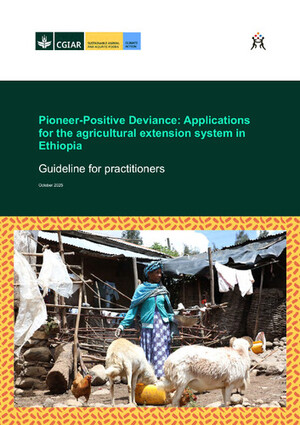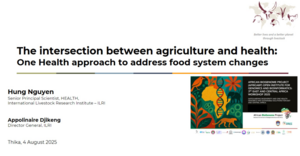
Climate change in Africa: What will it mean for agriculture and food security?
Mount Kenya’s glacier-clad peaks tower more than 5,000 meters above the plains below, making it the tallest mountain in Kenya and the second tallest in Africa after Kilimanjaro. The Mount Kenya ecosystem is an irreplaceable biodiversity hotspot that provides water for over 2 million people, and the surrounding landscape has long been one of eastern Africa’s most productive agricultural areas. However, rising temperatures over the past century have caused drastic changes in the Mount Kenya ecosystem, perhaps best illustrated by the steady retreat of Mount Kenya’s glaciers. Lewis Glacier, Mount Kenya’s largest, has shrunk by 90 per cent since the 1930s. At this rate, Mount Kenya could lose all its glaciers by 2030, becoming the world’s first major mountain range to lose its glaciers to human-induced climate changes.
Mount Kenya’s dying glaciers are symptomatic of an even bigger problem facing the African continent. Despite accounting for less than 4 per cent of global greenhouse gas (GHG) emissions, Africa finds itself at the epicentre of the global climate crisis. Extreme weather events will likely become more frequent and severe in Africa than anywhere else in the world, and the continent’s poverty, food insecurity and low adaptive capacity make it particularly vulnerable to climate impacts.
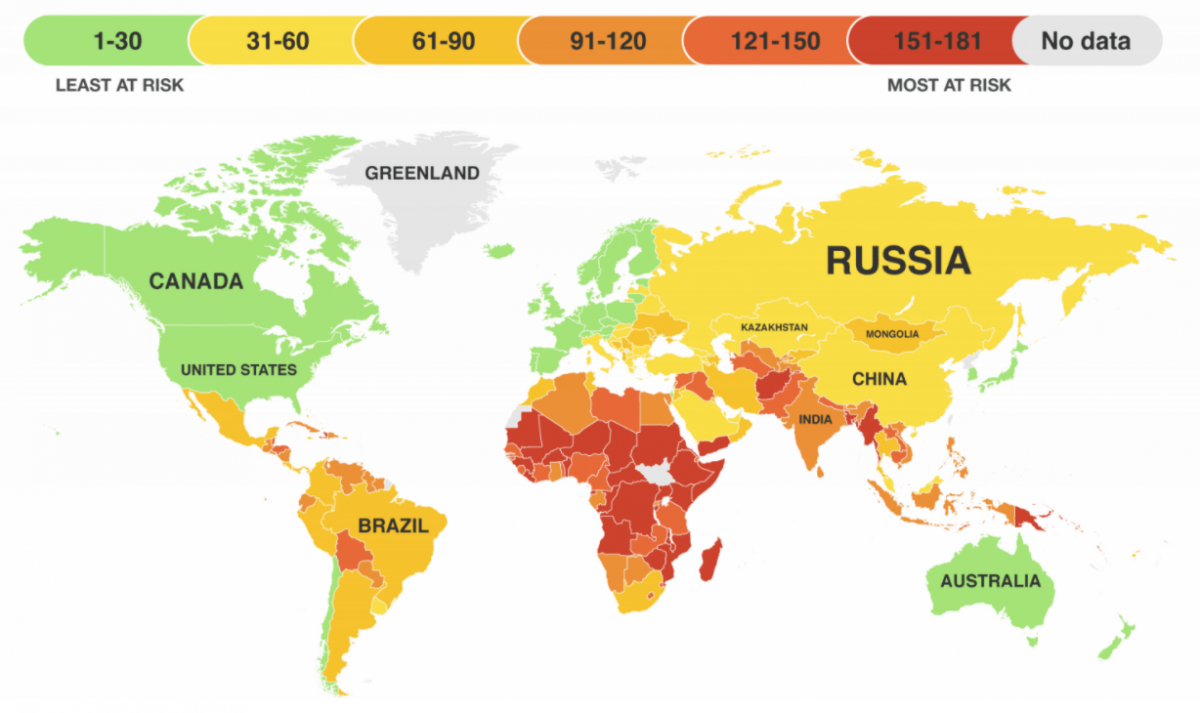
The countries most at risk from climate change. Based on data from the University of Notre-Dame’s ND-Gain Index, the map ranks 181 countries on their vulnerability to climate change and how ready they are to adapt to a warming planet.
Source: https://www.theecoexperts.co.uk/blog/countries-survive-climate-change-2…
The problem is compounded by Africa’s rapid population growth. Most experts agree that under current growth rates, Africa’s population will double by 2050 and then double again by 2100, eventually climbing to over 4 billion by the end of the century. Feeding this growing population will require significant advancements in Africa’s food systems. However, agricultural advances may be difficult to achieve if African farmers are at the mercy of increasingly severe climate impacts. To prepare for these future challenges, we need to understand how climate change will manifest itself in Africa and what impact it is likely to have on the continent’s agricultural systems.
The Intergovernmental Panel on Climate Change (IPCC) has outlined a range of future warming scenarios in Africa, all of which reveal just how serious the crisis is. Temperatures in Africa are projected to rise faster than the global average, ranging from increases of 0.2℃ per decade at the low end to more than 0.5℃ per decade at the high end. While those low-end scenarios, in which continental temperatures do not rise by more than 1.5℃ above pre-industrial levels, are still attainable, they become more unlikely each year the world fails to cut global emissions. At the same time, the IPCC’s worst-case scenarios, in which Africa warms 2℃ by 2050 and over 4℃ by 2100, are becoming increasingly realistic. While it is difficult to predict these warming scenarios’ impact in Africa, scientists are starting to give us a good idea–and their projections are frightening.
Under the IPCC’s ‘business-as-usual’ warming scenario, in which global emissions continue at their current rate and temperatures in Africa increase 4℃ by the end of this century, there will be significant changes in continental rainfall. These alterations are expected to follow a ‘dry gets drier and wet gets wetter’ pattern, under which Africa’s wet regions along the equator will see a 30 per cent increase in rainfall while the continent’s already dry regions will experience a 20 per cent decrease. As these changes intensify, Africa will experience prolonged periods of both drought and flooding depending on the region.
In east Africa, the increasing frequency of drought is already becoming evident. Before 1999, a drought caused by a poor or failed rainy season happened once every five to six years. Since 1999, poor rainy seasons are occurring every two to three years. Under this current trajectory, the portion of east Africa exposed to drought is expected to increase by up to 54 per cent by the end of this century. This would expose millions more to periods of extreme drought in east Africa alone, and the situation is even more desperate in Africa’s already drought-prone regions in the far north and south.
While drought currently affects more Africans than any other extreme weather event, floods are not far behind. Since the 1970s, sub-Saharan Africa has experienced a tenfold increase in flood events. In 2020, 1.2 million Africans were displaced by floods and tropical storms–more than twice the amount of people displaced by violent conflict. Unfortunately, the problem is only going to worsen in the future. The Indian Ocean is currently the fastest-warming ocean in the world and its temperatures could rise by as much as 2.7℃ over the course of this century. These warmer temperatures will allow tropical storms to absorb more water vapour and heat, creating stronger winds, heavier rainfall and more flooding when they make landfall.
Another climate impact that often goes underreported due to data gaps is extreme heat. While an increase in temperatures of 2 to 4℃ is already concerning, climate change will also intensify temperature extremes, resulting in potentially deadly heatwaves–take, for example, the summer heatwave Europe experienced in 2003 that killed more than 70,000 people. A rapid increase in continental temperatures, combined with a growing population, has led experts to predict that by the end of this century, 20 to 50 times more people in African cities will be exposed to extreme heat.
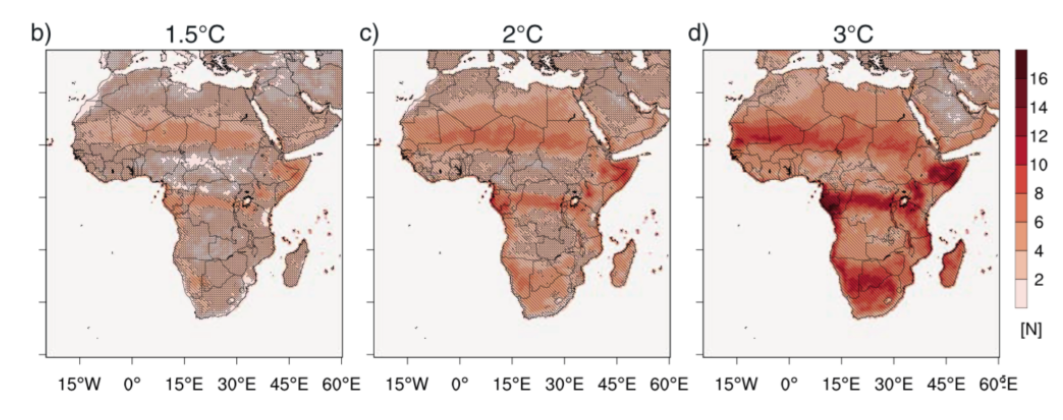
Growing danger of heatwaves. The three maps show the projected changes in mean annual heatwave days (N) under different levels of warming.
Source: Weber et al. (2018)
By the end of this decade, 118 million extremely poor people across Africa will be facing extended periods of drought, flooding and extreme heat as a direct result of climate change. Without urgent action to combat the growing climate crisis, many parts of North Africa (as far south as Sudan) could become uninhabitable by the end of this century. While these scenarios are certainly alarming, they are unfortunately just the tip of the iceberg. Climate change’s projected impacts on agriculture and food security are just as severe.
Hunger already affects 240 million Africans daily. By 2050, warming of just 1.2 to 1.9℃, well within the range of current IPCC projections, is likely to increase the number of malnourished in Africa by 25 to 95 per cent–25 per cent in central Africa, 50 per cent in east Africa, 85 per cent in southern Africa and 95 per cent in west Africa.
There are many reasons climate change poses such an immense challenge for African agriculture. Many crops foundational to African diets, such as wheat, maize, sorghum and millet, will struggle to survive rising temperatures. Under warming of 2℃, crop yields across sub-Saharan Africa will decrease by 10 per cent. Warming beyond the 2℃ mark will cause crops yields to fall by up to 20 per cent. If warming is allowed to hit the 3℃ mark, all present-day cropping areas for maize, millet and sorghum in Africa will become unsuitable. This would be devastating for Africa’s food security as sorghum and millet are both vitally important cereals in most African diets, and maize accounts for almost half of the calories and protein consumed in southern and eastern Africa.
Livestock are also vulnerable to Africa’s rising temperatures. A recent paper from International Livestock Research Institute (ILRI) scientist Philip Thornton projects a drastic increase in the number of days of extreme heat stress per year over the coming decades. This will make it increasingly difficult to raise livestock outdoors and could result in extended areas of the continent becoming unsuitable for livestock production by the end of the century. Losing the ability to keep livestock outdoors would be devastating for Africa’s food security as millions of people across the continent remain dependent on livestock for food. Livestock-derived foods are also vital in the fight against malnutrition.
Another looming threat to Africa’s agricultural systems is the dwindling availability of water. Up to 95 per cent of the continent’s farmers do not have irrigation systems, meaning they are entirely reliant on rainfall. With rainfall projected to decrease in many parts of Africa and the incidence of drought already rising rapidly, farmers living in the continent’s dry regions will struggle to find enough water to keep their crops and livestock alive. The Horn of Africa is currently experiencing its third consecutive failed rainy season, one that has destroyed crops, killed livestock and threatened the region with rampant food insecurity and hunger. Far from an aberration, the current drought is unfortunately a warning sign of things to come.
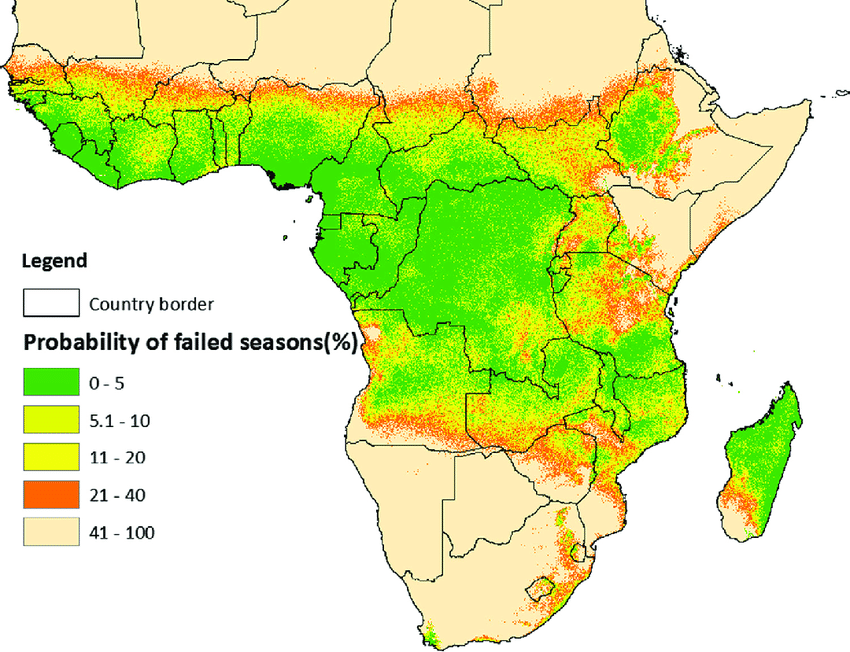
Drought risks and agriculture. The map shows the probability of a failed growing season due to drought in 2050 under the IPCC's A1 scenario. Adapted from Thornton et al. (2006).
Source: Shiferaw et al (2014)
It is not always a lack of water that poses the biggest threat to food production. In Africa’s coastal regions, floods and storms have already proven to be devastating for agriculture. In 2019, cyclone Idai tore across Mozambique, flooding fields, ripping crops from the ground and ultimately leaving more than 1 million people in need of immediate food aid. Even less damaging storms can still be very dangerous because crops and livestock are not able to survive for long after fields have been inundated with heavy rainfall and floodwaters.
An often-overlooked impact of climate change is the proliferation of agricultural pests. Warming temperatures and shorter winters will make it easier for pests to spread into new regions and will also allow them to reproduce more quickly and more often. Warming temperatures and changing rainfall patterns were a major impetus behind east Africa’s locust plagues of 2019. As the locusts spread across the region, they decimated crops and pastureland, leaving 13 million people at risk of severe food insecurity.
Taken altogether, the future of agriculture and food security in Africa does not look bright. Experts warn that under current climate projections, Africa will only be fulfilling 13 per cent of its food needs by 2050, causing African countries to lose up to 16 per cent of gross domestic product (GDP) as a result of malnutrition alone. Fortunately, there are still steps we can take to address the climate crisis and prevent this bleak vision of the future from becoming reality.
At the global level, efforts to address climate change should start with mitigation. The IPCC’s most dangerous warming scenarios are not set in stone, but they should serve as a warning that we can no longer delay global action to cut GHG emissions. While African agriculture and livestock do contribute to global GHGs, the African continent as a whole produces only a tiny sliver of the world’s total emissions. Therefore, global efforts to curb GHG emissions will have to be led by the world’s wealthier and more polluting nations.
As we have seen over the past couple of decades, however, climate change is no longer just an issue of the future. It is happening right now, and millions of people across Africa are already being affected. Therefore, adaptation strategies are just as important.
Adaptation begins with modernizing Africa’s agricultural sector. This will require significant investments in irrigation systems, improved infrastructure and wider access to financial instruments such as crop and livestock insurance. Research and development are also necessary to produce stress-tolerant crops and livestock breeds along with more sustainable methods of resource management.
There is also room for policy improvements. Policies should work to enhance global food security by integrating international markets and connecting farmers from around the world. They should also create incentives that attract youth back to rural areas to engage in sustainable farming and food production. To achieve success, policy frameworks cannot take a one size fits all approach but should instead be tailored to local conditions to account for the unique effects climate change will have in different parts of the world.
For too long, the world has neglected agriculture in Africa and failed to recognize its tremendous potential. However, as Africa faces increasingly severe climate impacts at the same time that its growing population demands ever-greater amounts of food, it is becoming evident that much of Africa’s future lies in the hands of its farmers. A lot of the technology required to improve farmers’ resilience to climate impacts, such as stress-tolerant crops and irrigation systems, already exists. Failing to get these innovations into the hands of African farmers will have catastrophic consequences for hundreds of millions of people. On the other hand, by working alongside African farmers to ensure they have the resources necessary to adapt to climate change and produce sufficient food for a growing population, we can lay the foundations for a healthy and prosperous Africa in the decades to come.
Arid soils in Mauritania (photo credit: Pablo Tosco/Oxfam)













